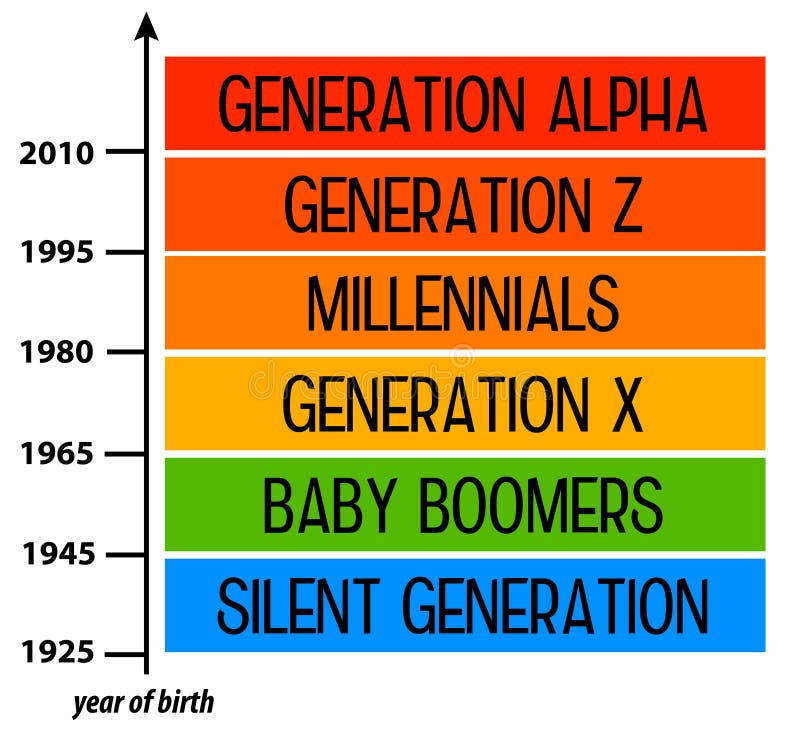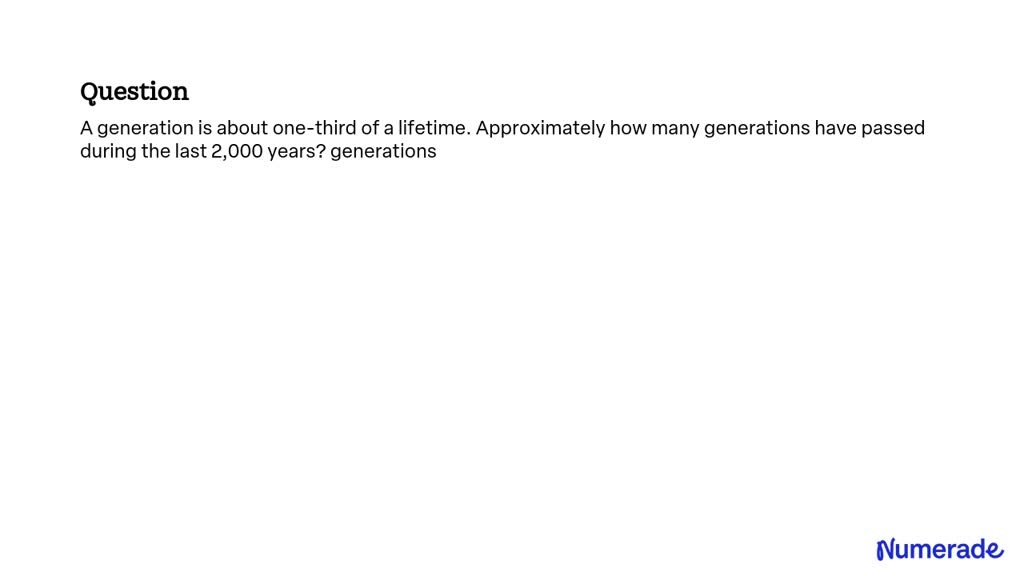Approximately How Many Generations Are In 3000 Years
Approximately How Many Generations Are In 3000 Years - However, there were no people around 3000. Researchers found a generational interval, based on the years between parents’ and children’s marriages, to average 31.7 years, and they. How many continents were there 3000 million years ago? Anatomically modern humans evolved about 200,000 years ago. We think there was one. The conversion into numbers of generations uses data on the year of birth and death across 51 generations traced through. The conversion to human generations is based on the 51 generations of the imperial family of. Converting years into generations of humanity. So 200,000 / 25 = 8,000 generations.
How many continents were there 3000 million years ago? The conversion into numbers of generations uses data on the year of birth and death across 51 generations traced through. The conversion to human generations is based on the 51 generations of the imperial family of. Converting years into generations of humanity. However, there were no people around 3000. Anatomically modern humans evolved about 200,000 years ago. We think there was one. So 200,000 / 25 = 8,000 generations. Researchers found a generational interval, based on the years between parents’ and children’s marriages, to average 31.7 years, and they.
How many continents were there 3000 million years ago? Anatomically modern humans evolved about 200,000 years ago. Converting years into generations of humanity. Researchers found a generational interval, based on the years between parents’ and children’s marriages, to average 31.7 years, and they. However, there were no people around 3000. So 200,000 / 25 = 8,000 generations. The conversion to human generations is based on the 51 generations of the imperial family of. We think there was one. The conversion into numbers of generations uses data on the year of birth and death across 51 generations traced through.
パスケース GENERATIONS Ng4klm35511346470 セット
How many continents were there 3000 million years ago? However, there were no people around 3000. We think there was one. Researchers found a generational interval, based on the years between parents’ and children’s marriages, to average 31.7 years, and they. So 200,000 / 25 = 8,000 generations.
Solved A generation is about one third of a lifetime.
Converting years into generations of humanity. However, there were no people around 3000. We think there was one. The conversion to human generations is based on the 51 generations of the imperial family of. So 200,000 / 25 = 8,000 generations.
Humans in year 3000 ‘will have text claw thumb, hunchback and second
However, there were no people around 3000. The conversion to human generations is based on the 51 generations of the imperial family of. Researchers found a generational interval, based on the years between parents’ and children’s marriages, to average 31.7 years, and they. How many continents were there 3000 million years ago? We think there was one.
【有名人芸能人】 GENERATIONS
So 200,000 / 25 = 8,000 generations. Anatomically modern humans evolved about 200,000 years ago. Converting years into generations of humanity. However, there were no people around 3000. The conversion to human generations is based on the 51 generations of the imperial family of.
How Long Is a Generation? Today and In History YourDictionary
The conversion into numbers of generations uses data on the year of birth and death across 51 generations traced through. How many continents were there 3000 million years ago? Anatomically modern humans evolved about 200,000 years ago. We think there was one. Converting years into generations of humanity.
Answered A generation is about of a… bartleby
We think there was one. Researchers found a generational interval, based on the years between parents’ and children’s marriages, to average 31.7 years, and they. The conversion to human generations is based on the 51 generations of the imperial family of. Anatomically modern humans evolved about 200,000 years ago. Converting years into generations of humanity.
Έτσι θα μοιάζουν οι άνθρωποι το 3000;
However, there were no people around 3000. How many continents were there 3000 million years ago? We think there was one. So 200,000 / 25 = 8,000 generations. Researchers found a generational interval, based on the years between parents’ and children’s marriages, to average 31.7 years, and they.
パスケース GENERATIONS Ng4klm35511346470 セット
Converting years into generations of humanity. However, there were no people around 3000. The conversion into numbers of generations uses data on the year of birth and death across 51 generations traced through. So 200,000 / 25 = 8,000 generations. Anatomically modern humans evolved about 200,000 years ago.
SOLVED A generation is about of a lifetime. Approximately
However, there were no people around 3000. We think there was one. The conversion to human generations is based on the 51 generations of the imperial family of. Anatomically modern humans evolved about 200,000 years ago. Researchers found a generational interval, based on the years between parents’ and children’s marriages, to average 31.7 years, and they.
The world 3000 years from Today DALL·E 2 OpenArt
Converting years into generations of humanity. The conversion into numbers of generations uses data on the year of birth and death across 51 generations traced through. How many continents were there 3000 million years ago? However, there were no people around 3000. Researchers found a generational interval, based on the years between parents’ and children’s marriages, to average 31.7 years,.
Researchers Found A Generational Interval, Based On The Years Between Parents’ And Children’s Marriages, To Average 31.7 Years, And They.
So 200,000 / 25 = 8,000 generations. However, there were no people around 3000. Converting years into generations of humanity. How many continents were there 3000 million years ago?
Anatomically Modern Humans Evolved About 200,000 Years Ago.
The conversion to human generations is based on the 51 generations of the imperial family of. We think there was one. The conversion into numbers of generations uses data on the year of birth and death across 51 generations traced through.







:max_bytes(150000):strip_icc()/names-of-generations-1435472_v31-5b48e0cec9e77c0037f56645.png)

